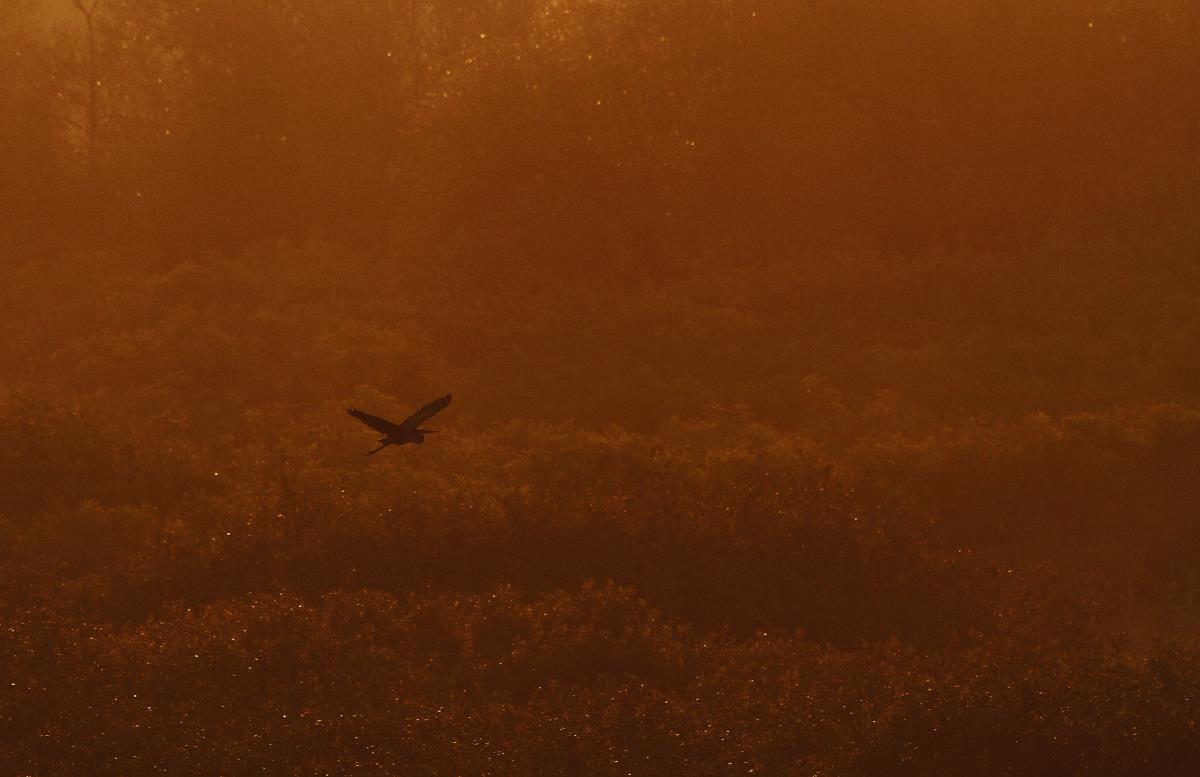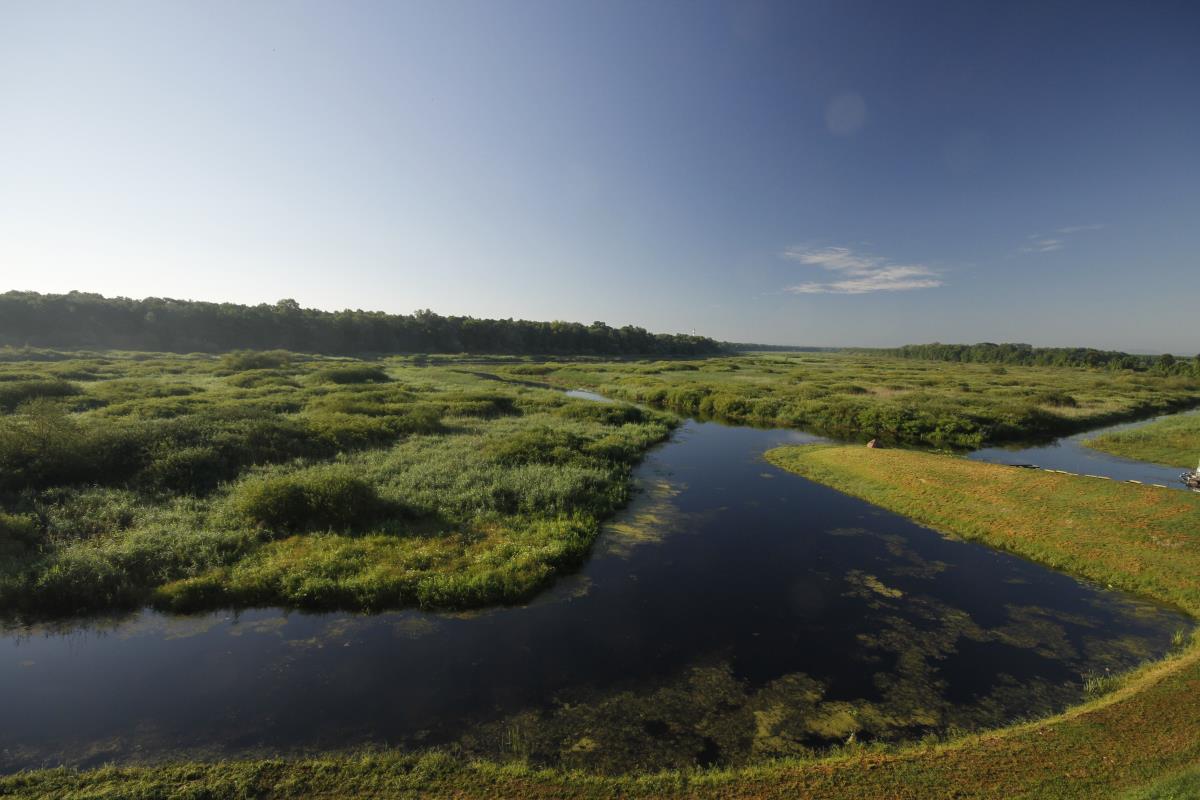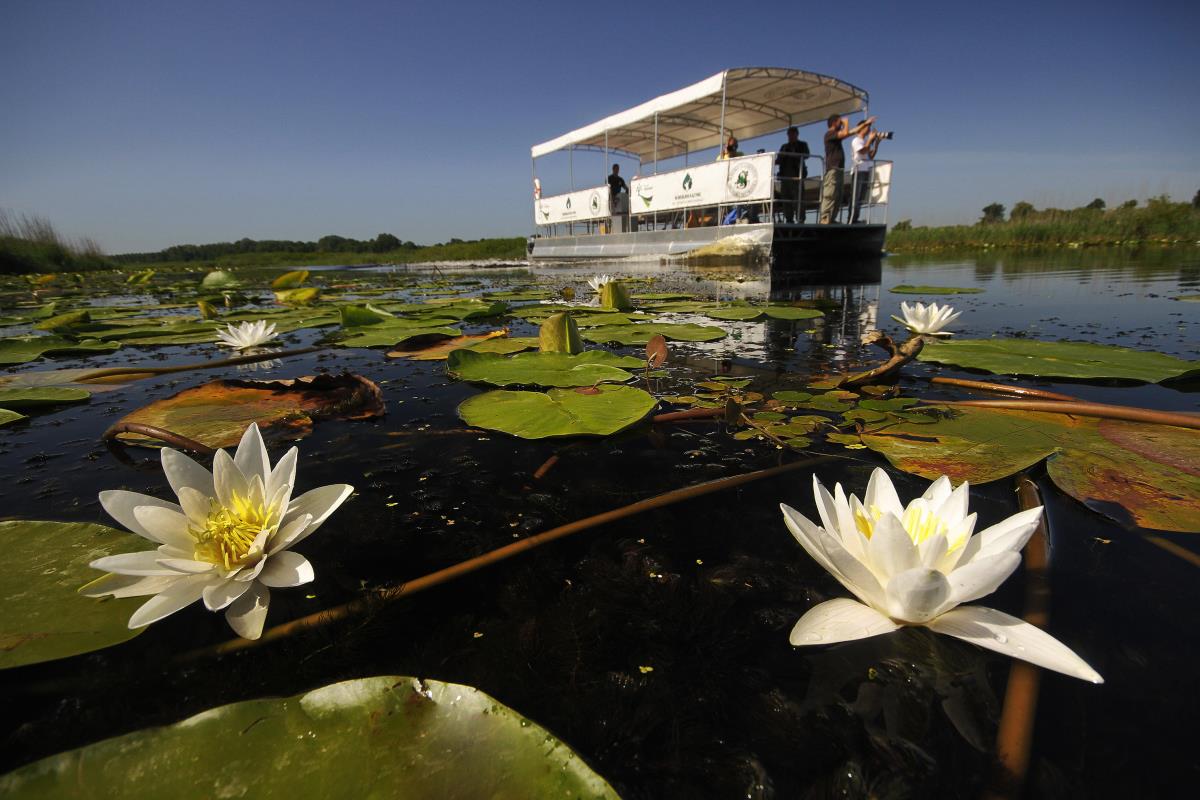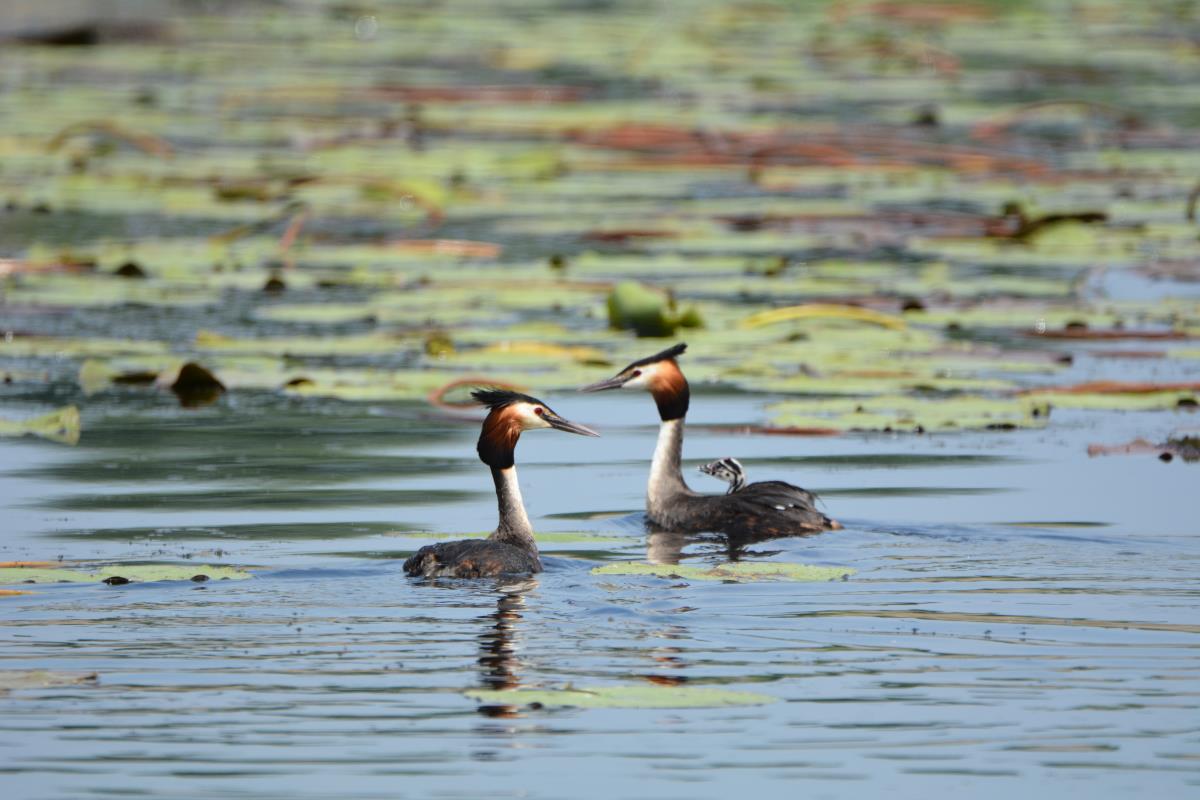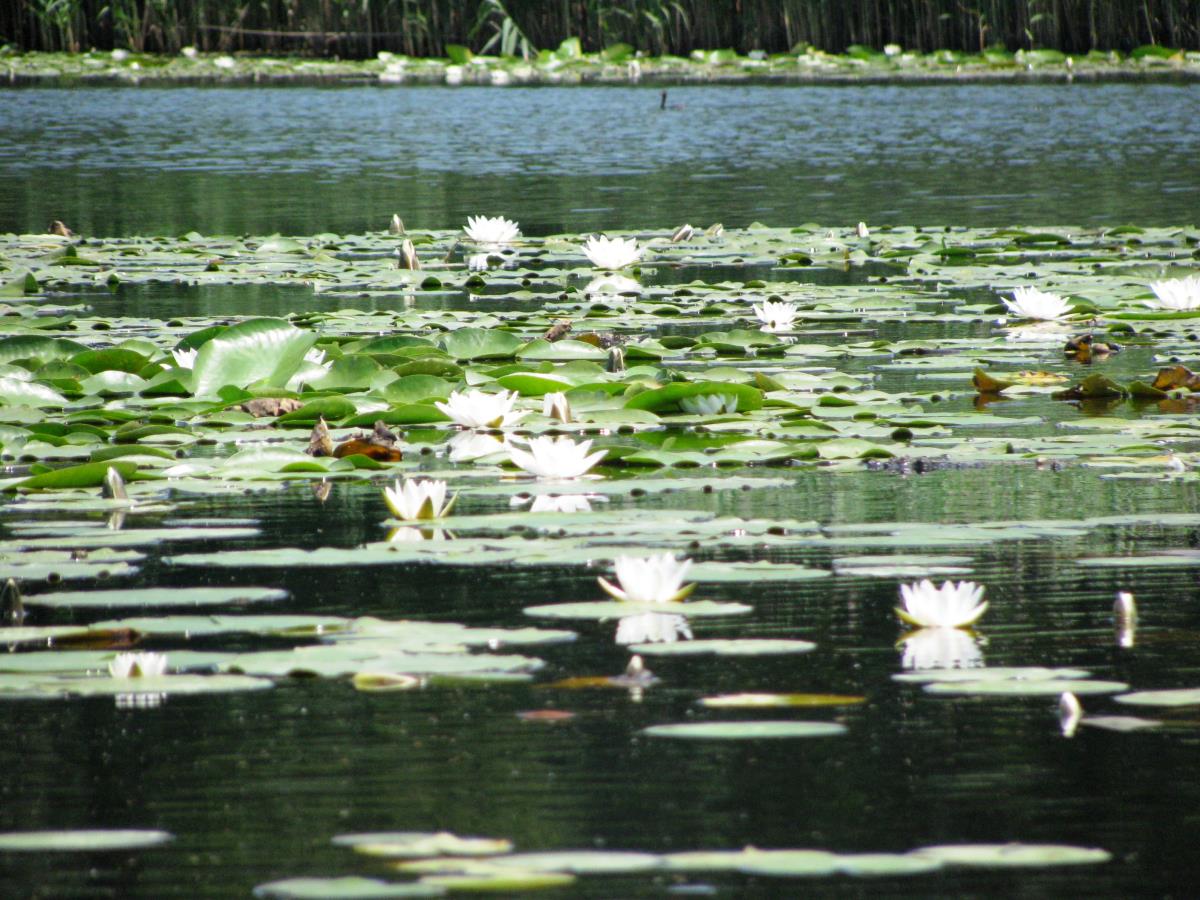OBEDSKA BARA SPECIAL NATURE RESERVE
Category of protection: Special nature reserve
Year of protection: 1994
Location
Once a famous ornithological reserve and today a special nature reserve, this vast swamp-forest complex is located along the Sava river in the south of Srem region between villages Obrež, Ašanja, Kupinovo, Progar and the Sava River. It spreads on the territory of Pećinci and Ruma municipalities. In the narrow sense, Obedska bara represents Sava River meandre whose main course flows more towards the south. The Obedska bara extends in the shape of a horseshoe between villages Obrež and Kupinovo. The length of the arch is about 13.5 km and the maximum width is 750 m. The surface of the pond is changing, and today it is about 7 km2. The altitude varies from 71 m' to 73 m'.
History
In the 19th century Obedska bara was strictly protected Austro-Hungarian hunting ground, and after the World War I the protected area and hunting ground of the Kingdom of Serbo-Croatians and Slovenians. Even though hunting for privileged noblemen was occasionally organised, the birds were strictly protected between the hunts, therefore they could always restore their numbers, primarily because their nesting and feeding areas would remain untouched. Following the Second World War, on the 15th December 1951, protection of the area as a Special Natural Reserve was established, based on the Decision of the Institute for the Protection and Scientific Study of Natural Rarities of the Serbia, in Belgrade. Potkovica and the terrain of 200m around it, covering the total area of 1,060 ha, was put under the full protection. All marshes within Kupinske grede were also strictly protected. Thereupon, on the 31st October 1968, the Municipality of Pećinci declared, as a Natural Reserve, an area that covered 17,501 ha, with three different adjoined natural assets (Strict Natural Reserve 602 ha, Scientific-Research Reserve 766 ha, Area of Outstanding Natural Beauty 16,133 ha). In 1994, the protection was unified through the establishment of the Special Nature Reserve “Оbedska Bara”, declared by the Government of the Republic of Serbia, for the territory of 9,820 ha.
Tourism
The Special Nature Reserve “Obedska bara” offers many different choices for tourists:
- The Centre for information and education, established in 2011, is located close to the Obrež village and it is intended for the visitors of the SNR “Obedska bara”. The capacity of the Centre is 40 persons.
- There is a circular education path, with a total length of 7 km, and a waterside pathway, total length of 5 km, equipped with 4 monitoring watchtowers. There are also 4 water mirrors, a bird island, porches, direction signposts and information panels. The catamaran (capacity of 25 persons) and boats are at the visitors’ disposal . At the entrance of the SNR there are two guides for the reception of the visitors.
- The circular education path is equipped with 3 porches, tables and benches and is located in the heart of the Reserve. The path provides excellent opportunity of observing swamp habitat with waterfowl, old forest stand, especially of the English oak, and of the rare and medicinal herbs.
- The waterside pathway, located on the edge of the swamp, starts from the “Obed Tower”, goes over the small bridge and passes by the monitoring watchtower “Matijevica”, from which the waterfowl colonies can be observed. The path ends at the second monitoring watchtower “Spomenik”. All the way, the path goes through the forests of the English oaks and white poplar, allowing for the walking and sightseeing of the Obedska bara, its diversity in flora and fauna, especially the birds.
- In the “Horeshoe” of the swamp, there are “water mirrors” and “the bird island”, whose aim is to improve additional feeding of wetland birds and keeping them in the Obedska bara reserve. There are several significant historical and cultural monuments in the vicinity of the reserve: the “Kupinik” fortress, the church of Mother Angelina and the church of Saint Lucas.
Natural values
Obedska bara (The Obed swamp) – The myth and the legend. This swamp has been famous worldwide since the mid-19th century, when stories of a ‘bird heaven’ first started. The greatest value of this area lies in its authentic combination of stagnant tributaries, ponds, pits, swamp vegetation, wet meadows and forests with exceptional diversity of ecosystems and species, especially the endangered ones. Obedska bara is one of the few remaining inundated marshes with distinctive features, such as hundred years old mixed English oak forests, waterfowl colonies and numerous natural rarities. This swamp represents a remnant of the former Sava meander, located along its old riverbed. The main course of the river now flows more towards the south. Obedska bara is famous for its different marsh and forest habitats, numerous species of mammals, fish, amphibians, reptiles, insects and exceptional abundance of flora, ichtyofauna and above all ornithofauna. Due to its exceptional natural values, Obedska bara has been included in the Ramsar Convention list in 1977. It was the first site of such kind in Serbia. In 1989 it was declared the international Important Bird Area (IBA).
The crucial animal species in this area are the white-tailed eagle, the black stork, the egret, beaver etc. Some of the rare plant species one can find here are: the white and the yellow water lily, calamus, frogbit, pond iris and other.
The crucial animal species in this area are the white-tailed eagle, the black stork, the egret, beaver etc. Some of the rare plant species one can find here are: the white and the yellow water lily, calamus, frogbit, pond iris and other.
Sights
- The Church of Mother Angeline is situated on a small elevation along the edge of the Obedska Bara, opposite of Potkovica and across Kupinovo, within the old Obed monastery complex. One of the oldest Serbian churches built from wood stood there for centuries. There is a deep-rooted belief among the native population of this area that the church of the female Obed Monastery was built in 1486 by a despotess Angelina Branković, as a sign of gratefulness to God for ensuring her safe arrival home. It was built of wood and construction material used from the boat on which she sailed to Kupinovo with her sons and the holy remains of her husband Stefan.
- Kupinik, the capital town in the Middle Ages, built probably in mid-14th century, is situated on the bank of the south-eastern side of Potkovica. As a Hungarian military fortification, it was built from broken stone and covered by brick. Its primary purpose was to control the crossing point on the Sava River, opposite of Debrc, the former court of King Dragutin.
Known about the unknown
- The Obed Monastery, i.e. the restored Church of Mother Angeline, formerly a log-built church, is the only religious building in Serbia whose immediate surrounding is flooded on a regular basis.
- It may seem almost unbelievable, but the pollen research in the peat deposits of the Obedska Bara conducted by Milovan Gajić, have demonstrated that a long time ago, coniferous trees like spruce, fir and pine grew around this area. It is a known fact that coniferous trees were widely spread in many areas in this part of Europe during Preboreal period. In the Boreal phase they were completely replaced by broadleaved oak forests, which was also the case in the region of the Obedska Bara.
- The first bird ringing for scientific purposes, for the territory of the former Yugoslavia and the whole Balkan Peninsula, was performed by Jakob Schenk and his associates in the Obedska Bara on 28th June 1908. The first ringed specimens were the Eurasian spoonbills (Platalea leucorodia). Thereafter, in 1911 and 1912 the first barn swallows (Hirundo rustica) and white storks (Ciconia ciconia) were also ringed by the local associate Ž. Žarković in Kupinovo. Schenk and his associates returned to the Obedska Bara to ring the birds again on the 16th and 17th June 1912; and it was reported already the following year that certain species of herons that nested in the Obedska Bara were found in Africa.
- Since the beginning of time, the inhabitants of Obrež and Kupinovo have been wary of “mire spots” with mud in the Obedska Bara bed, while unfamiliarity with its pits and dangerous places cost the unaware individuals their lives. A forked branch sinks over 3 meters down into the mushy mud, just as any other heavier object. The gruel mud is covered with a hardened crust that may fool people. When only one sallow tree starts to sway on that unstable ground surface, all other trees, at the distance of several tens of meters, start to swing as well. During the First and the Second World Wars, several hundreds of soldiers disappeared in the quagmire, while some drowned in Degurić, Vujić and Krstonošić pits. In 1961, Marković passed on the inhabitants’ stories saying that a saddle or a sword, or even parts of the soldiers’ uniforms could still be spotted in the marsh’s brushwood from time to time. The inhabitants are still telling the stories about alleged planes and drawn wagons that disappeared forever in the quagmire of the Obedska Bara. Between the two wars, Pongratz passed on the villagers’ stories saying that entering the Obedska Bara meant tempting God, since the marsh’s methane gas could stupefy an incautious visitor. He also added “… underneath the seemingly hard crust a deep marsh is hidden, and those who once enter it have to sink there never to see the Sun again”.
The area is open for visitors:
- Working hours (for visitors): 7a.m – 7p.m., every day during whole year
- Prior notice: yes, to Ivana Lozjanin, ivana.lozjanin@sgsmitrovica.rs, +38162626014
- Additional important information: catering is an option but for groups of more than 15 persons with previous announcement
This area is managed by PE “Vojvodinašume“
- Address: PE „Vojvodinašume, Preradovićeva 2, 21131 Petrovaradin
- Telephone number: +38121431144
- Official website: www.vojvodinasume.rs
